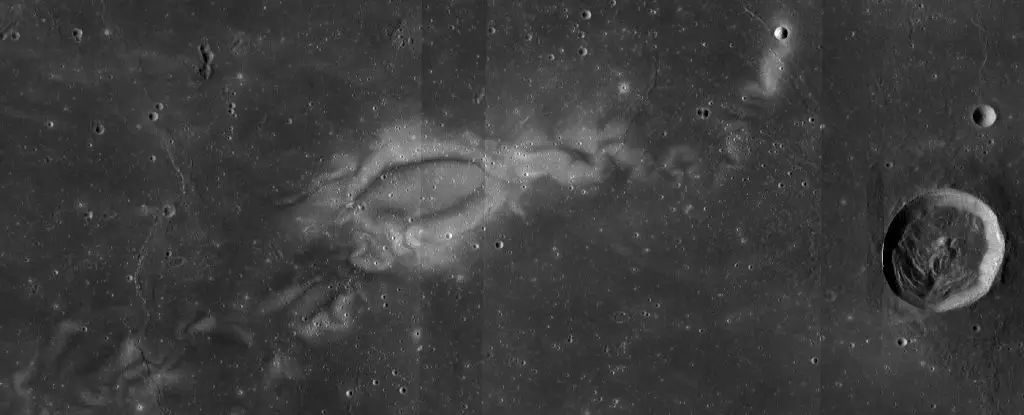The Moon, Earth’s celestial companion, holds many mysteries that continue to baffle scientists. One such enigma is the presence of swirling patterns etched into its surface, known as lunar swirls. These beautiful and perplexing features have long puzzled researchers, as their origin and formation process remain elusive. However, recent studies have revealed a crucial connection between lunar topography and the shape of these enigmatic curlicues. This newfound understanding could potentially unlock the secrets behind lunar swirls and shed light on the Moon’s history.
Lunar swirls are intricate swirling patterns that can be observed on the Moon’s surface, both in the dark mare and the bright highlands. These peculiar formations consist of bright curling lines, interspersed with darker gaps. Every known lunar swirl discovered thus far coincides with a magnetic field over the lunar surface, creating a protective barrier against space weathering. Scientists hypothesize that this magnetic field deflects solar particles that would otherwise affect the swirls and the surrounding terrain.
For years, it was believed that the shape of the Moon’s surface had no bearing on the location or shape of lunar swirls. However, recent research indicates otherwise. Scientists studying the Mare Ingenii region noticed that the bright lines within a lunar swirl were situated at lower elevations than the darker lanes between them. This groundbreaking discovery challenged the prevailing notion and prompted further investigation.
In an effort to corroborate these findings, planetary scientist Deborah Domingue and her team focused their attention on the famous Reiner Gamma swirl. Utilizing data from the Lunar Reconnaissance Orbiter Camera, they employed advanced analytical techniques, including machine learning, to examine the topography of the surface with greater precision. Astonishingly, their results mirrored those of the Mare Ingenii swirl, with the bright areas being approximately 4 meters lower than the dark areas.
While this revelation indeed strengthens the link between topography and lunar swirls, the relationship is not as straightforward as initially assumed. A direct comparison between an elevation map and a picture of the swirl does not demonstrate a uniform elevation difference. Instead, the correlation emerges when comparing the average height of the bright areas to that of the dark areas. This nuanced connection emphasizes the complexity of understanding lunar swirl formation.
Unveiling the Moon’s Secrets
The discovery of elevation changes in two lunar swirls suggests that the observations in the Mare Ingenii region were not isolated incidents but indicative of a broader trend. However, this intriguing breakthrough is far from explaining the cause behind these enigmatic phenomena. Nevertheless, each piece of information gained through meticulous studies and observations serves as a valuable clue in unraveling the secrets of lunar swirls.
As scientists continue to explore the Moon and gather data, numerous hypotheses have emerged to explain the formation process of these swirls. However, none have yet offered a complete understanding or a unified explanation. Contradictory observations and multiple viable hypotheses underscore the complexity of lunar swirl formation. Scientists speculate that their genesis may involve a combination of well-understood processes or perhaps a yet-to-be-discovered mechanism.
The Moon, devoid of the dynamic geologic processes that shape Earth’s surface, offers an alternative perspective on planetary formations. Lunar swirls, in particular, provide a unique opportunity to study the Moon’s history and the hidden workings beneath its tranquil surface. With no similar features found on Earth, lunar swirls hold untapped anecdotes and potential revelations about our cosmic neighbor.
Researchers remain driven to uncover the truth behind lunar swirls. While they navigate the complex maze of theories, observations, and data, their collective efforts bring them closer to comprehending these captivating lunar anomalies. Every breakthrough fuels scientific curiosity and expands our understanding of the Moon, making the mysteries of lunar swirls both challenging and captivating to explore.
Intricate and captivating, lunar swirls continue to captivate scientists with their enigmatic presence on the Moon’s surface. Recent studies linking lunar topography to the shape of these swirls shed new light on their formation process. While many unanswered questions remain, each revelation brings us closer to unraveling their mysterious secrets. By delving deeper into these unique lunar features, we inch closer to unlocking the Moon’s history and the remarkable stories it has yet to reveal.


Leave a Reply